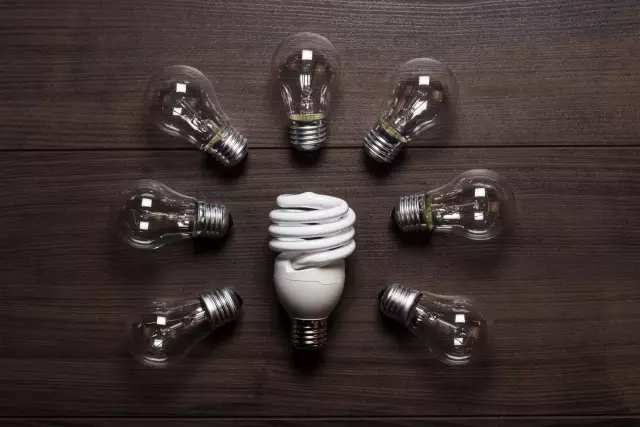- Author Rachel Wainwright [email protected].
- Public 2023-12-15 07:39.
- Last modified 2025-11-02 20:14.
Energy saving lamps: 4 facts about possible health risks
Energy saving lamps are one of the most popular products of innovative technologies, and it is not surprising: they are much more economical and more durable than the usual incandescent lamps. At the same time, it is believed that energy-saving light bulbs cause health problems. Unfortunately, there are a number of real grounds for this opinion.

Source: depositphotos.com
Ultraviolet irradiation
Manufacturers warn that every eight hours of being under an energy-saving lamp in terms of the amount of UV radiation received by a person can be equated to an hour in the open air on a sunny day. The harmful radiation is partly blocked by the glass from which the lamp is made, but the portion is still pretty solid. True, official research has not been carried out, the manufacturers' statements have to be taken on faith.
In any case, while in a room illuminated by energy-saving lamps, one should take into account the likelihood of adverse effects of ultraviolet rays on the skin and eyes.
Pulse operation
The specificity of the functioning of most energy-saving lamps is that the light is not emitted evenly, but in the pulsation mode - the intensity of their glow about 100 times per second weakens and increases again. It has been proven to be harmful to the nervous system and vision.
People who are forced to stay in rooms lit by energy-saving lamps every day for several hours often suffer from obsessive headaches, dizziness, and imbalance. They complain of eye pain, fatigue, and insomnia.
Today, more modern lamp models are being developed, which should operate at 300 pulsations per second. Such a frequency is not recorded by the human nervous system, and the harmful effects of lighting devices will be minimized.
Mercury vapor
Each energy saving light bulb contains 3 to 5 mg of mercury. This is not much, and as long as the glass shell of the lamp is intact, nothing threatens its owners. Only cracked or broken light bulbs are dangerous: vapors of poisonous metal, released into the air, very quickly spread throughout the room and settle on furniture, curtains, clothes, and are absorbed into the floor. Living in an apartment contaminated with mercury is fraught with the development of severe damage to the kidneys, liver, brain and bone marrow, and other organs and tissues.
We must not forget that in most cases the light bulbs that have fallen into disrepair are thrown away along with the rest of the household waste, since the system of separate disposal in our country is very poorly developed. As a result, the toxic substance enters the soil and groundwater, poisoning the environment.

Source: depositphotos.com
Effects on allergy sufferers
For people with delicate, sensitive skin, being near energy-saving lamps can cause allergic reactions - burning, itching and swelling. (It should be noted that this is extremely rare.) Such patients are usually advised to choose light sources equipped with additional protective shades, or give preference to LEDs.
Modern man will not give up the use of high-tech devices. From this, however, it does not follow that he is doomed to be a victim of their harmful effects on the body. It is quite possible to avoid health problems, you just need to competently approach the use of such things, take into account the specifics of their functioning and observe safety precautions, minimizing risks.
YouTube video related to the article:

Maria Kulkes Medical journalist About the author
Education: First Moscow State Medical University named after I. M. Sechenov, specialty "General Medicine".
Found a mistake in the text? Select it and press Ctrl + Enter.






